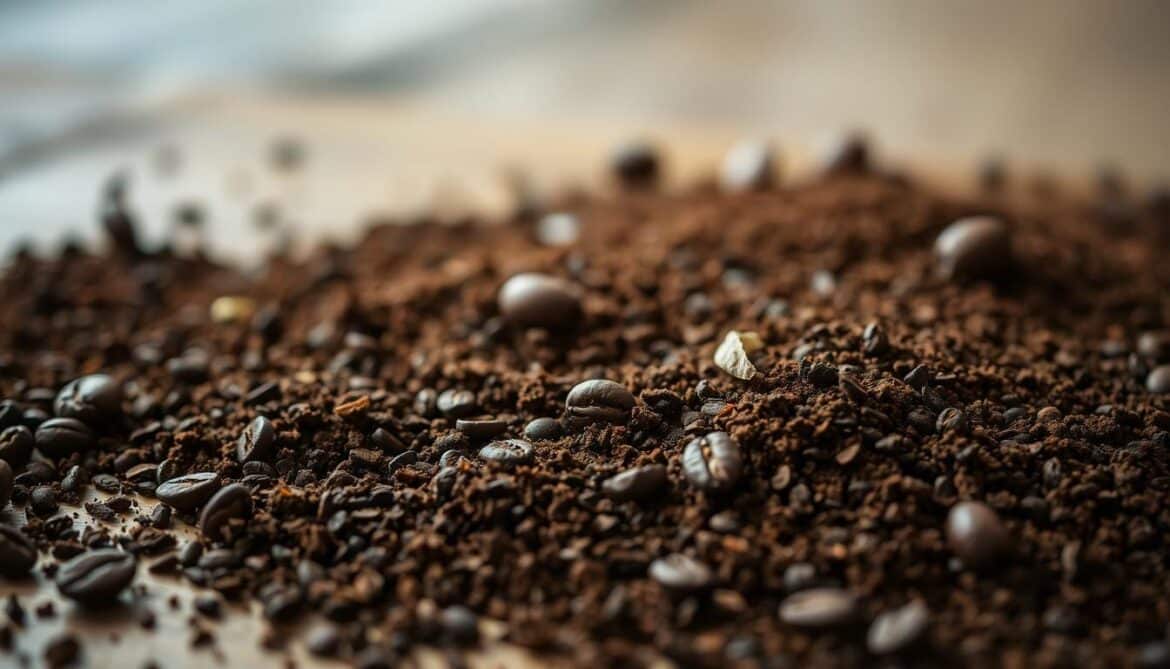Every morning, you brew your favorite cup of coffee. But what do you do with the grounds afterward? Instead of throwing them away, you can use them to help your garden grow. Coffee grounds are full of nutrients that can make your plants healthier.
More gardeners are now using coffee grounds to improve their soil. This not only helps their plants but also reduces waste. This guide will show you how to use coffee grounds to make your garden better and cut down on waste.
Key Takeaways
- Coffee grounds enrich soil with nitrogen and minerals.
- Repurpose waste into a natural fertilizer for acid-loving plants.
- Reduce pests like slugs while improving soil structure.
- Easy to mix with compost or use directly around plant bases.
- Aligns with sustainable practices for eco-friendly gardening.
What Are Coffee Grounds?
Coffee grounds are what’s left after brewing coffee. But they’re more than just kitchen waste. They’re packed with nutrients that are great for gardening. These grounds come from finely ground coffee beans and keep their nutrients even after they’re used.
Composition of Coffee Grounds
Each coffee grounds for plants has:
- Organic matter that enriches soil structure
- Natural acids like chlorogenic acid
- Residual oils and fibers
Nutrient Content
Here’s what you get in 1 cup (200g) of used coffee grounds:
| Nutrient | Amount | Plant Benefit |
|---|---|---|
| Nitrogen | ~2% | Fuels leaf growth |
| Phosphorus | 0.5% | Promotes root development |
| Potassium | ~0.6% | Strengthens stems and flowers |
Benefits for Plants
These nutrients help plants grow strong. Nitrogen makes leaves green, and phosphorus helps flowers bloom. The benefits of coffee grounds for plants also include:
- Acidic pH suits acid-loving plants like blueberries
- Microbial activity stimulation
- Natural pest-repelling properties
Benefits of Using Coffee Grounds in Gardening
Make your garden healthier with coffee grounds. These leftovers are full of surprises. They can really help your soil and plants:
Enhancing Soil Quality
- They add organic matter to soils, making them better for roots and air.
- The nitrogen in them feeds good microbes, making the soil rich in nutrients.
- They also stop soil from getting too hard, making it easier to work with.
Improving Water Retention
Coffee grounds are like tiny sponges. They hold onto water without making the soil too wet. This helps plants stay healthy during dry times and cuts down on watering by 20-30%.
Attracting Earthworms
Earthworms love the smell of coffee. They help break up the soil as they move through it. A USDA study showed that worms doubled in number in soil with 10% coffee grounds.
| Benefit | Effect |
|---|---|
| Soil Structure | Loosens clay, improves drainage |
| Moisture | Retains water for 20-30% longer |
| Worm Activity | Boosts population by up to 100% |
When using coffee grounds, remember to use them in moderation. Start with small amounts and watch how your plants do. With time, these simple steps can make your garden flourish and reduce waste.
How to Add Coffee Grounds to Your Soil
Make your garden better with these easy steps. You can add them directly or mix them in. These methods will help your plants grow well.
Direct Application Techniques
Spread coffee grounds in thin layers, no more than a quarter inch thick. Place them around the base of plants, but keep them 2 inches from stems. This prevents moisture from causing problems.
Use this method every week, but only add half a cup per square foot. Make sure the grounds are dry before applying to avoid mold.
Mixing with Compost
Add coffee grounds to compost piles at a 20% ratio. Mix them with dried leaves or shredded paper to balance out the mix. Turn the compost pile weekly to help it break down faster.
This makes a coffee grounds compost for plants that improves soil over time. It’s full of nutrients.
Creating a Fertilizer Blend
- Combine equal parts coffee grounds, crushed eggshells, and banana peels for a mineral-rich mix.
- Add 1 part grounds to 3 parts peat moss for seedlings.
- Dilute strong brew by mixing 10% coffee grounds with potting soil for potted plants.
Keep unused blends in airtight containers to keep nutrients in. Test small amounts on plants first to make sure they work well.
Best Plants for Coffee Grounds
Not all plants like coffee grounds the same way. Choose wisely to get the most benefits without making the soil too acidic.
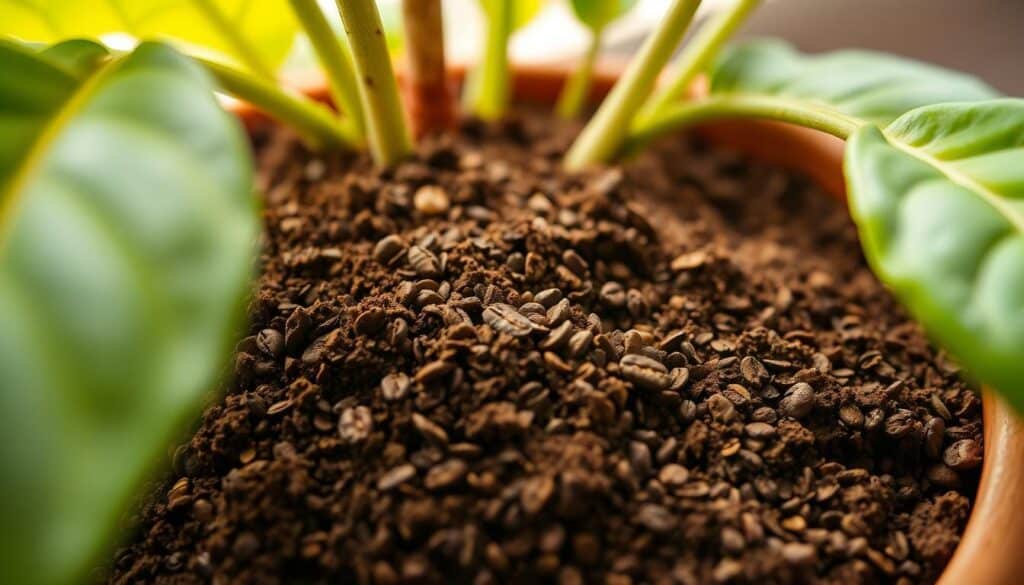
Acid-Loving Plants
Azaleas, blueberries, and hydrangeas love the coffee grounds acidity for plants they need. They do best in soil with a pH of 5.5-6.0.
| Plant | Benefit | Application |
|---|---|---|
| Azaleas | Acid boost | Layer 1″ around base |
| Blueberries | Root health | Mix 1:3 with soil |
| Rhododendrons | Leaf color | Topdress monthly |
Vegetables and Herbs
Tomatoes, peppers, and herbs like rosemary get a nitrogen boost from grounds. Pinto beans also grow well with compost.
- Carrots: Sprinkle grounds lightly to deter pests
- Radishes: Use grounds as mulch for faster growth
- Basil: Sprinkle sparingly near herb roots
Indoor Plants
Ferns and spider plants can handle small amounts. Apply 1/4 cup every month:
- Peace lilies: Mix 1 tsp with potting soil
- Orchids: Use grounds as topdressing
- Mint: Sprinkle dried grounds for fragrance
Always rinse used grounds before using them on indoor plants to avoid mold.
Using Coffee Grounds as Pest Control
Coffee grounds are a natural way to keep gardens safe. Many gardeners use coffee grounds in plant care to keep pests away. The caffeine and oils in coffee repel pests, making it a great tool for gardeners.
Repelling Insects
Caffeine in coffee grounds messes with the nervous systems of ants, beetles, and fruit flies. Sprinkle a thin layer around plants to keep them safe. For a spray, mix dried grounds with water. Here’s how to use it right:
- Apply dry grounds around plant bases for ants and beetles.
- Use a 1:1 ratio of grounds and water for foliar sprays against flying pests.
- Reapply after rain to keep pests away.
Deter Snails and Slugs
Snails and slugs don’t like the gritty texture and acidity of coffee grounds. Spread a 2-inch-wide ring of dry grounds around plants to keep them safe. Refresh weekly, after watering. For the best results:
- Layer grounds loosely to prevent clumping.
- Combine with crushed eggshells for extra protection.
- Avoid overapplication to prevent soil acidity imbalance.
While coffee grounds work for some pests, they’re not a fix-all. For tough problems, mix them with other methods like companion planting (see integrated pest management techniques). Always watch your plants and adjust your plan as needed to keep your garden balanced.
How to Brew Your Coffee for Gardening Benefits
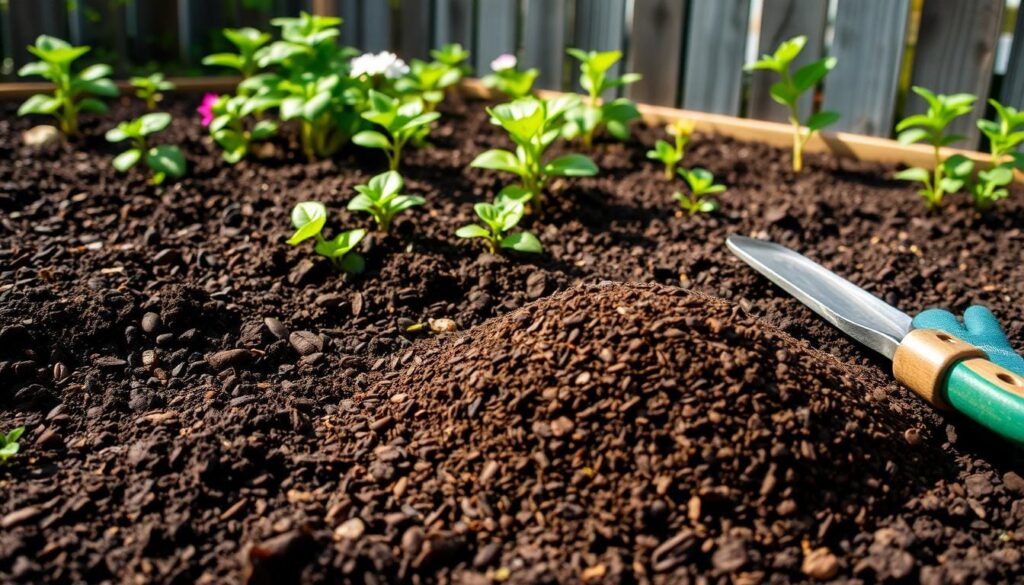
Every morning’s brew has hidden benefits for your garden. The way you brew your coffee affects the nutrient value of the grounds. For coffee grounds for plants, the best brewing methods keep nutrients like nitrogen and potassium.
Making the Most of Used Grounds
Extraction methods impact nutrient availability. Here are some tips:
- French Press: Less extracted grounds are rich in nitrogen, great for roses or tomatoes.
- Espresso: High-extraction methods leave less nutrient-rich grounds—use these as mulch or compost additive.
- Drip Coffee: Moderate extraction makes grounds perfect for general soil mixes.
Let used grounds dry completely before storing in airtight containers. This preserves nutrients. Mix with compost for even distribution of benefits.
Using Fresh Grounds Responsibly
Fresh, unbrewed grounds can boost acidity. Use them sparingly for coffee grounds recycling in gardening:
- Apply to acid-loving plants like blueberries or azaleas.
- Mix with soil at a 1:4 ratio to avoid over-acidification.
- Layer thin—no more than ½ inch—to prevent waterlogging.
“A little planning turns morning brew into garden gold.” – ChikusGarden’s guide
Adjust your brewing habits to meet your garden’s needs. Whether using fresh or brewed grounds, careful preparation boosts their role in sustainable coffee grounds recycling in gardening. Small changes in your coffee routine can greatly benefit your plants.
Common Myths About Coffee Grounds
Coffee grounds are great for plants, but myths confuse their benefits. Knowing the truth helps gardeners use them right.
Misconceptions in Gardening
- Myth 1: Coffee grounds make soil too acidic. Actually, brewed grounds don’t change soil pH much.
- Myth 2: All plants love coffee grounds. But, some like tomatoes and roses do well, while others like lavender don’t.
- Myth 3: Fresh grounds are better. But, used grounds are safer for plants because they lose harsh acids during brewing.
Science vs. Myths
A 2019 study by Washington State University debunked myths. It showed that coffee grounds don’t change soil pH much. Grounds do add nitrogen, which helps plants grow. But, too much can harm earthworms.
Experts say to mix grounds with compost to prevent clumps. Don’t use more than 20% of the soil volume. These details are often overlooked.
Storage and Preservation of Coffee Grounds
Keeping coffee grounds fresh is key for using coffee grounds in plant care. Here’s how to store them for gardening.
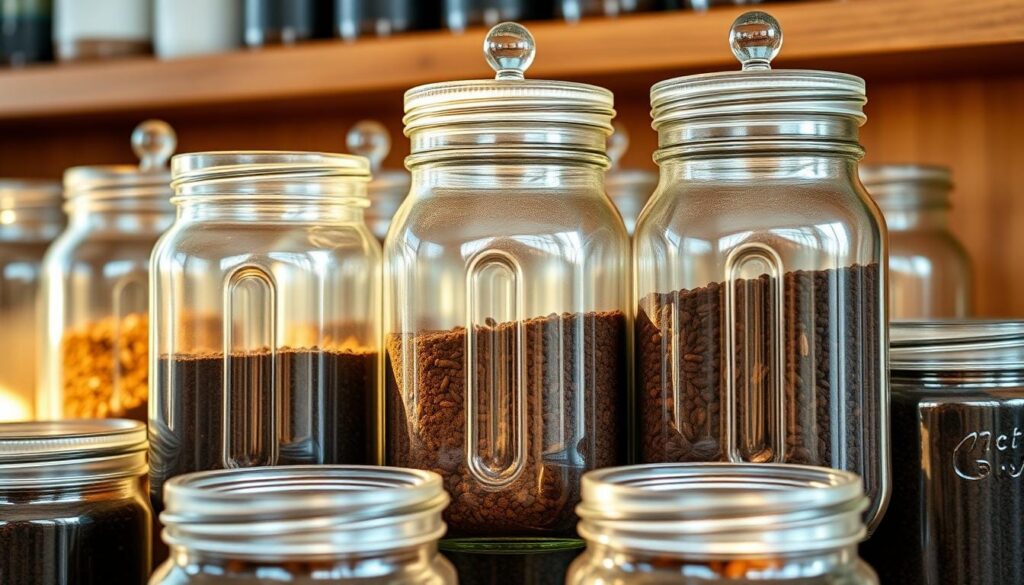
Best Practices for Freshness
- Use airtight containers like glass jars or zip-lock bags to keep moisture out
- Dry the grounds well by spreading them on a tray in the sun or using a dehydrator
- Store containers in cool, dark spots like pantries or basements
Avoiding Mold and Odor
Here’s how to stop spoilage:
- Check for dampness every day before sealing containers
- Use a paper towel to soak up any extra moisture
- Throw away moldy grounds and clean the containers
| Storage Method | Pros | Cons |
|---|---|---|
| Airtight jars | Blocks oxygen and pests | Needs to be completely dry |
| Paper bags | Natural airflow stops mold | Not as durable for long storage |
| Freezer storage | Keeps nutrients for months | Needs freezer space |
Coffee grounds recycling in gardening needs good storage. Check if they smell good—sweet and earthy means they’re good. Change them out every 2–3 weeks for the best results.
Balancing Coffee Grounds with Other Materials
Coffee grounds are great for soil when mixed with other organic stuff. This mix gives plants the nutrients they need without overloading the soil. Gardeners need to know how coffee grounds work with compost and other waste.
The Role of Carbon-Nitrogen Ratio
For coffee grounds compost, a 25:1 carbon-to-nitrogen ratio is key. Coffee grounds are rich in nitrogen, so adding carbon-rich stuff like dried leaves is a good idea. This balance stops soil from getting too acidic. Here’s how to mix:
- Use 4 parts carbon-rich materials (like straw or shredded paper)
- Add 1 part coffee grounds
- Mix thoroughly for even decomposition
By following this ratio, you avoid water-repellent soil layers, as garden guides suggest.
Combining with Green Waste
Pair coffee grounds with green waste like fruit peels or grass clippings for the best compost. These add to microbial activity. Here’s what to mix:
- Vegetable scraps (nitrogen source)
- Dead leaves (carbon source)
- Used tea bags (moisture retention)
Layer these in compost bins to make nutrient-rich soil. Coffee grounds alone don’t work as well; they’re better with a mix.
Coffee Grounds and Soil pH Levels
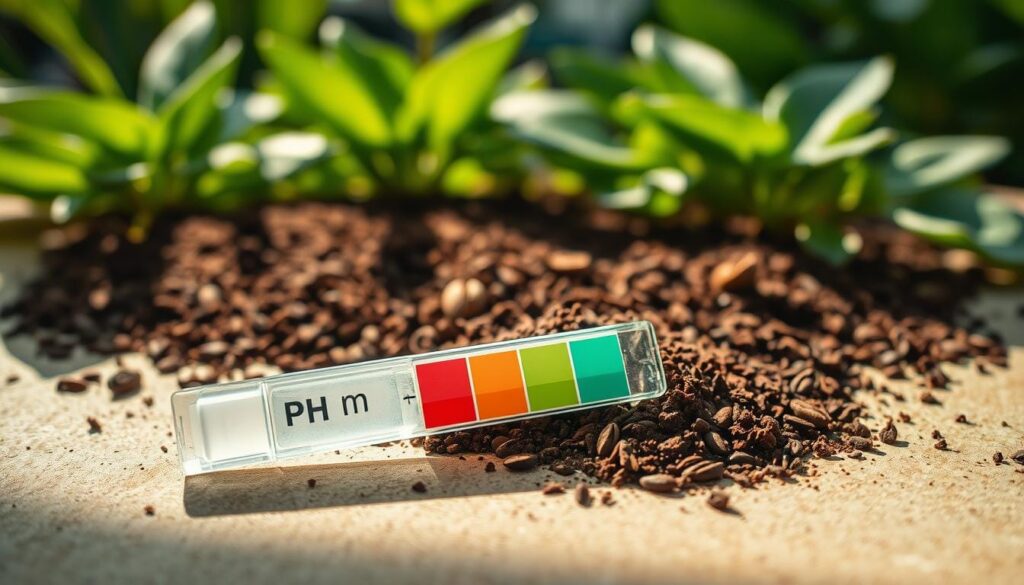
Soil pH is key to plant health, as it affects how nutrients are absorbed. Many think coffee grounds are too acidic for plants, but research shows this isn’t always true. Here’s how to use coffee grounds to improve soil without upsetting its balance.
Understanding Soil pH
Soil pH ranges from 0 (acidic) to 14 (alkaline). Most plants do best in a pH of 6.0–7.0. Acid-loving plants, like blueberries, need a pH of 4.5–5.5. It’s important to test soil pH yearly to make the right adjustments.
How Coffee Affects pH
Used coffee grounds have a pH of 6.5–6.8, according to Oregon State University research. Key points:
- They add very little acidity, unlike compost or fertilizers.
- Too much can make the soil compact, blocking water and nutrients.
- Adding lime or sulfur can help adjust the pH if needed.
For coffee grounds acidity for plants, always test the soil first. Don’t add more than 20% coffee grounds to soil mixes. This way, coffee grounds can improve soil structure without affecting pH.
Use coffee grounds sparingly on acid-loving plants. Check soil pH yearly to keep it at the best level for growth. Always use caution and test before adding to get the best results.
Using Coffee Grounds in Seed Starting
Coffee grounds can help seedlings grow strong. They add moisture and nutrients like nitrogen to the soil. This gives young plants a great start.
Benefits for Seedlings
Coffee grounds make the soil better at holding water. They also have a mild acidity that many plants like. The microbes in the grounds help break down organic matter, giving plants the nutrients they need.
Studies show that mixes with 10-20% coffee grounds can increase germination rates by up to 15%.
How to Incorporate into Seed Starting Mix
- Combine 1 part dried grounds with 3 parts potting soil for a balanced mix.
- Top seed trays with a thin layer of grounds to deter fungus gnats.
- Avoid fresh, wet grounds which can overheat soil; always use cooled, dried material.
Too much coffee grounds can cause problems. If seedlings have yellow leaves, it means there’s too much nitrogen. Start with small amounts to see how plants react.
“Moderation is key. Coffee grounds are a supplement, not a standalone medium,” advises the National Gardening Association.
Coffee Grounds for Mulching
Turn kitchen waste into a garden asset by using coffee grounds as mulch. This method supports using coffee grounds in plant care and coffee grounds recycling in gardening. When used right, it offers long-term soil support.

Advantages of Mulching with Coffee Grounds
Coffee mulch has four main benefits:
- Moisture retention: Keeps water in the soil up to 30% longer.
- Temperature control: Protects roots from extreme temperatures.
- Weeds blocked: Prevents sunlight from reaching weed seeds.
- Nutrients released slowly: Provides nitrogen over weeks, not days.
| Benefit | Impact |
|---|---|
| Moisture Retention | Maintains soil dampness 2x longer than bare soil |
| Weed Suppression | Reduces weed growth by 50% in first month |
Application Steps
- Spread 1-inch layer around plant bases, keeping clear of stems.
- Blend with 1:1 ratio of shredded leaves for airflow.
- Top with straw or compost to prevent surface drying.
Apply every 6 weeks during growing season. Avoid piling thick layers to prevent crust formation. Mix with pine needles or bark for better drainage.
Challenge solution: If mulch clumps, break up with a rake and add coarse material like shredded wood. Always keep layers under 2 inches to avoid suffocating roots.
Environmental Impact of Using Coffee Grounds
Using coffee grounds in gardening does more than help plants. It also protects our planet. In the U.S., over 15 million tons of food waste are thrown away each year. Coffee grounds are a big part of that. By using them, gardeners help reduce waste and cut down on methane, a harmful gas.
Reducing Waste in Landfills
Organic waste like coffee grounds makes up 15% of U.S. landfill volume. When we compost or use them in gardens, they don’t contribute to methane. The USDA found that using food scraps like coffee can reduce landfill waste by up to 30% in cities. Just mixing grounds into soil helps keep waste out of landfills and feeds plants.
Sustainability Benefits for Gardening
- Less chemical fertilizer use: Coffee grounds naturally enrich soil, reducing the need for store-bought products.
- Closed-loop systems: Using grounds completes the “brew-to-soil” cycle, minimizing resource waste.
- Water conservation: Grounds improve soil structure, cutting irrigation needs by up to 25% for some plants.
Using coffee grounds in gardening is good for the planet. Home gardeners can lower their carbon footprint and grow healthier plants. Small actions like using coffee grounds can make a big difference. It shows that eco-friendly gardening can start in your own backyard.
Frequently Asked Questions About Coffee Grounds
Using coffee grounds for plants can be beneficial. But, it’s important to know their limits. Here are answers to common questions gardeners have:
Are coffee grounds safe for all plants?
Coffee grounds are good for plants that like acidic soil, like azaleas and hydrangeas. But, they might not be good for plants that prefer alkaline soil. Seedlings and tomato plants can get too acidic if there’s too much.
Always check your soil’s pH before using coffee grounds a lot. And, keep them away from pets. Caffeine in coffee grounds can be harmful if pets eat it.
How often can I use coffee grounds?
You can use coffee grounds for plants every 4–6 weeks. Using them too much can cause problems like yellow leaves or slow growth. Plants in containers need even less because their soil is smaller.
Mixing coffee grounds with compost can help. It makes the caffeine less strong.
Can I use flavored coffee grounds?
No, don’t use flavored or sugared coffee grounds. The oils and sugars can attract pests or cause mold. Stick to plain, brewed coffee grounds for the best results.
Plain coffee grounds are best for plants like roses and rhododendrons. They like acidic soil.
